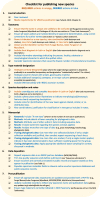How to publish a new fungal species, or name, version 3.0
- PMID: 33934723
- PMCID: PMC8091500
- DOI: 10.1186/s43008-021-00063-1
How to publish a new fungal species, or name, version 3.0
Abstract
It is now a decade since The International Commission on the Taxonomy of Fungi (ICTF) produced an overview of requirements and best practices for describing a new fungal species. In the meantime the International Code of Nomenclature for algae, fungi, and plants (ICNafp) has changed from its former name (the International Code of Botanical Nomenclature) and introduced new formal requirements for valid publication of species scientific names, including the separation of provisions specific to Fungi and organisms treated as fungi in a new Chapter F. Equally transformative have been changes in the data collection, data dissemination, and analytical tools available to mycologists. This paper provides an updated and expanded discussion of current publication requirements along with best practices for the description of new fungal species and publication of new names and for improving accessibility of their associated metadata that have developed over the last 10 years. Additionally, we provide: (1) model papers for different fungal groups and circumstances; (2) a checklist to simplify meeting (i) the requirements of the ICNafp to ensure the effective, valid and legitimate publication of names of new taxa, and (ii) minimally accepted standards for description; and, (3) templates for preparing standardized species descriptions.
Keywords: Data repositories; Dual nomenclature; FAIR principles; Legitimate publication; New combinations; Taxonomic best practices; Typification; Valid publication.
Conflict of interest statement
The authors declare they have no competing interests.
References
-
- Aoki T, Smith JA, Mount LL, Geiser DM, O’Donnell K. Fusarium torreyae sp. nov., a pathogen causing canker disease of Florida torreya (Torreya taxifolia), a critically endangered conifer restricted to northern Florida and southwestern Georgia. Mycologia. 2013;105(2):312–319. doi: 10.3852/12-262. - DOI - PubMed
-
- Ariyawansa HA, Hawksworth DL, Hyde KD, Jones EBG, Maharachchikumbra SSN, Manamgoda DS, Thambugala KM, Udayanga D, Camporesi E, Daranagama A, Jayawardena R, Liu JK, McKenzie EHC, Phookamsak R, Senanayake IC, Shivas RG, Tian Q, Xu JC. Epitypification and neotypification: guidelines with appropriate and inappropriate examples. Fungal Diversity. 2014;69(1):57–91. doi: 10.1007/s13225-014-0315-4. - DOI
-
- Bezerra JDP, Oliveira RJV, Paiva LM, Silva GA, Groenewald JZ, Crous PW, Souza-Motta CM. Bezerromycetales and Wiesneriomycetales Ord. Nov. (class Dothideomycetes), with two novel genera to accommodate endophytic fungi from Brazilian cactus. Mycological Progress. 2017;16(4):297–309. doi: 10.1007/s11557-016-1254-0. - DOI
Grants and funding
LinkOut - more resources
Full Text Sources
Other Literature Sources

